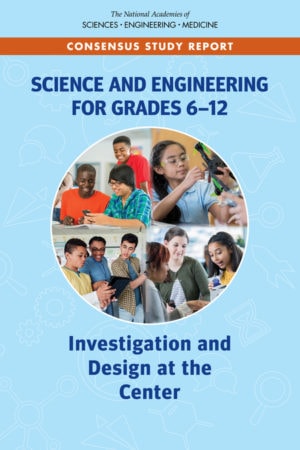 In November of 2018, the National Academies of Sciences Engineering & Medicine released a new report that found centering science instruction around investigation and design can improve learning in middle and high schools and help students make sense of phenomena in the world around them. The study, sponsored by the Amgen Foundation and the Carnegie Corporation of New York, also found that many science classrooms today do not support these engaging approaches to learning, and changing instruction will require significant and sustained work by teachers, administrators, and policy makers. To dive more deeply into the Science and Engineering for Grades 6-12: Investigation and Design at the Center report, we invited Nancy Songer, one of the co-chairs of the committee that developed the report, and Scott Heimlich of the Amgen Foundation for a Q&A to share their thoughts on why investigation and design should be at the center of learning.
In November of 2018, the National Academies of Sciences Engineering & Medicine released a new report that found centering science instruction around investigation and design can improve learning in middle and high schools and help students make sense of phenomena in the world around them. The study, sponsored by the Amgen Foundation and the Carnegie Corporation of New York, also found that many science classrooms today do not support these engaging approaches to learning, and changing instruction will require significant and sustained work by teachers, administrators, and policy makers. To dive more deeply into the Science and Engineering for Grades 6-12: Investigation and Design at the Center report, we invited Nancy Songer, one of the co-chairs of the committee that developed the report, and Scott Heimlich of the Amgen Foundation for a Q&A to share their thoughts on why investigation and design should be at the center of learning.
 Dr. Nancy Songer, Distinguished University Professor, Drexel University
Dr. Nancy Songer, Distinguished University Professor, Drexel University
- What were the report’s key findings and why is it relevant for teachers?
- First, research studies tell us that science investigation and engineering design are more effective for supporting learning than traditional teaching methods. As a result, investigation and design should be the central approach for teaching and learning science and engineering.
- Second, science investigation and engineering design entail a dramatic shift in the classroom dynamic. Students ask questions, participate in discussions, create artifacts and models to show their reasoning, and continuously reflect and revise their thinking.
- Teachers are viewed as the change agents in guiding, framing, and facilitating investigation and design in classrooms. The report calls on teachers and administrators to provide high-quality, sustained, professional learning opportunities so that all teachers can come to realize effective evidence-based instructional practices.
- How does this new approach make quality science education more accessible for all, especially marginalized students?
- The report emphasizes the importance of using local phenomena for investigation and design and choosing instructional materials that include information on strategies and options teachers can use to craft and implement lessons relevant to their students’ backgrounds, cultures and place.
- The report also asks state and national legislatures and departments of education to provide additional resources to schools with significant populations of underserved students to broaden access and opportunity, and allow all students to participate in science investigations and engineering design.
- What role do schools and district administrators play in creating science investigation and engineering design experiences for all students?
- The report calls on school and district staff to systematically review policies that impact the ability to offer science investigation and engineering design opportunities to all students. They should monitor and analyze differences in course offerings and content between schools, as well as patterns of enrollment and success in science and engineering courses. Administrators should use this information to construct specific, concrete and positive plans to address the disparities.
- The report also asks administrators to support teachers in the implementation of science investigation and engineering design. This may include providing teachers with appropriate instructional resources, opportunities to engage in sustained professional learning experiences and work collaboratively to design learning sequences, choose phenomena with contexts relevant to their students, and time to engage in and learn about inclusive pedagogies to promote equitable participation in science investigation and engineering design.
- Can you tell me a bit more about the upcoming webinars on 3/28?
- On March 28th at 1 pm ET, two members of the study committee, Brett Moulding and Anne Egger, will lead a discussion on pre-service and in-service teacher preparation and teacher professional learning. You can register here: https://nasem.zoom.us/webinar/register/WN_khbaAajbSmCpmU-KTzEITA
 Dr. Scott Heimlich. Vice President, Amgen Foundation
Dr. Scott Heimlich. Vice President, Amgen Foundation
- Why did the Amgen Foundation sponsor this report with Carnegie?
- Amgen and our industry utilizes rigorous evidence to bring a medicine from bench to bedside, and we apply that mindset to the philanthropic impact we seek to achieve through the Amgen Foundation. In the world of science education – and for many other fields – the National Academies sets the bar in providing expert advice on our most pressing challenges, gathering experts from across the country who analyze the latest evidence, draw conclusions as to the findings supported by that evidence and then issue recommendations. These recommendations shape sound policies, inform public opinion, and advance the pursuit of science, engineering, medicine and education.
- As the Amgen Foundation funds the Amgen Biotech Experience – a very large high school laboratory program that now reaches 90,000 students annually across the U.S. and the globe – we are just one of the audiences eager to learn the latest evidence as it relates to laboratory science in our nation’s high schools. Along with educators, curriculum developers, school districts, funders and so many others who care about science education at the secondary level, we are learning from the report’s conclusions and recommendations so that the latest research can inform our priorities and practice.
- Does the Foundation support any programs or initiatives that align with the findings from the report?
- The report is clear that “one effective way to help students learn is to engage them in science investigation and engineering design.” The new and free online platform LabXchange – which is still under development and will launch this Fall, supported by the Amgen Foundation – is being built to prepare and engage students to do just that.
- Students will be able to design an experiment, execute it, fail, troubleshoot, redesign it, and then execute it again – at the end, getting a virtual data outcome that they would see if they were in the lab. This ability to let students engage in the scientific process, on a platform that will allow teachers to customize content so that they can best meet the needs of learners at whatever stage they are, will be a powerful online tool that is meant to prepare more students not just for success in labs, but ultimately for science careers. Most importantly, a platform like this – similar to the Amgen Foundation’s support of biology content on Khan Academy – can engage students everywhere, regardless of financial status or geography.
- How do the goals of the Foundation connect to Amgen’s mission to serve patients?
- Amgen’s reason for being is to serve patients. The Amgen Foundation, the main philanthropic arm of Amgen Inc., seeks to advance excellence in science education to inspire the next generation of innovators.
- We can’t see twenty years into the future, but we do know that for the biopharmaceutical industry to be successful in the fight against cancer and other serious illnesses, we’ll need the next generation of scientists to come from the ranks of today’s students, wherever and whoever they may be. With programs like the Amgen Biotech Experience at the high school level, Amgen Scholars at the college level, and those such as LabXchange that have the potential to engage students from California to Calcutta, the Amgen Foundation is doing its part to give every student the opportunity to experience science – and one day foster that breakthrough that benefits us all.
Read more about the Science and Engineering for Grades 6-12: Investigation and Design at the Center report here: Investigation and Design Can Improve Student Learning in Science and Engineering; Changes to Instructional Approaches Will Require Significant Effort[/text_output][/vc_column][/vc_row]